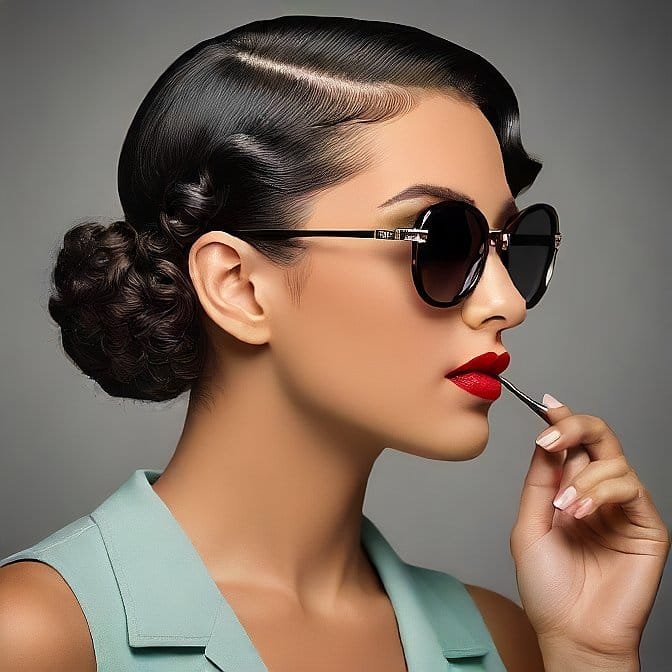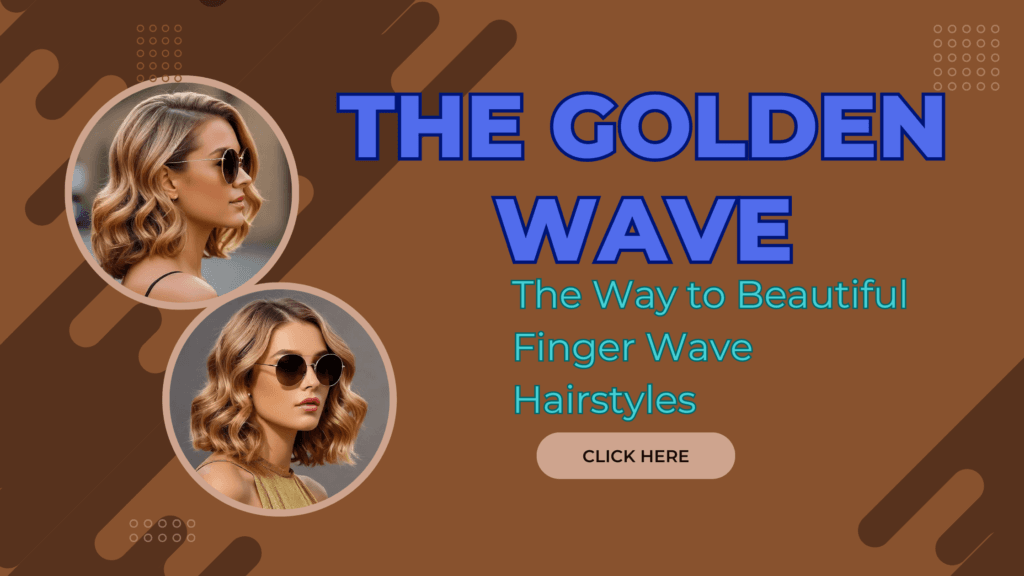Table of Contents
Introduction

Finger wave hairstyles are elegant and superb. Guys love scraped-back hair, especially when combined with sculptural waves which not only elongate the hair but give it this touch of old Hollywood glamour. Although finger waves started in the 1920s and were immensely trendy in the 1930s and 1940s; today’s adaptations can still be seen as popular in red carpet entrances and fashion magazines.
The Brief History of Finger Wave Hairstyles
Finger wave styles originated in the early 1920s, the same time that fashion was ushering in some of the most famous haircuts, including the bob. First, there was the Marcel Wave which, with the help of the curling iron, was invented by the French stylist Francois Marcel. But the people wanted waved hairstyles so badly that soon enhancements in it were learned.
The method of finger wave utilized combs and hands; the waves were sculptural continuous and unbroken. The finish and style gave no curls or waves produced by heating tools, but only the curls and waves created by the stylist. Finger waving was also easier to do by the average woman at home and saved a great deal of time as compared to the hot irons.
The finger-wave styles were at their peak in the 1930s so both, favorite stars of that time such as Jean Harlow and Ginger Rogers wore them. Women went to barbershops to have their hair styled in the lovely fashion of the exaggerated ‘Sinead waves’.
These intricate shapes gradually disappeared from popular culture, although it took the whole of the 1940s and 1950s, yet waves could still be found in notebooks Fashion edits, and more energetic and elegant pinup girls like Dita Von Teese. Today these romantic, retro breezy waves persist to dictate the latest fashion trends of designers’ collections and red carpet moments.
How to Make Finger Waves

Even though there may be styles that can be created on heat tools labeled as finger waved, authentic finger waved styles are exclusively created with the use of the hairstylist’s fingers and combs. Simply creating themselves defined, lasting waves is something that would necessitate time and effort.
- Sectioning
- The first step requires them to section the hair into groups that are clean and dried. Generally, parts may run from the forehead to the back of the ear to provide suitable rows for waves, while triangles may give more definition to waves on shorter hair.
- Wave Setting
- To wave a client’s hair, the stylist uses the tip of the comb and swirly or scoop motions to paint the wave pattern. Any water-soluble lotion or gel that is applied to the hair and allowed to set will give this type of hold. Therefore, each section needs to be wound smoothed and pinned for approximately 5 to 15 minutes before they are set.
- Speaking of volume, flat fingers are pressed to the ridges of a waveform while cooling. Fine, some of the sections may be backcombed by a stylist as well.
- Finishing
- After the waves cool down, and they have set, hair stylists take down the pins, reinstall the fallen parts, and apply suitable hair gel, pomade, or a lightweight hairspray. The finger combs also combine the waves into smooth ridges over the head region as well.
Check Out: The Finger Wave Ponytail: A Glamorous Look Combining Vintage Waves and Modern Flair.
Modern Interpretations
The sculptural perfection of true vintage waves inspires modern interpretations:
Classic Waves
The best finger waves can replicate date Timeless looks of the style that was sported by starlets in the 30s and 40s. Voluminous, set waves are followed from the temporal area to the temporal area for strong and expressive emphasizing.
Partial Waves
In the modern world, they may introduce finger-styled waves around the face or at the crown in order to obtain focal points. The waves can best be described as flowing and free, and are best accompanied by loose curls or even straight hair.
Exaggerated Waves
Trends on the catwalks involve highly architectural forms, massive sculptural waves on top of the head in magnificently theatrical large selection.
- Loose Waves
- As special event hair, loose waves at the ends will appear more casual than the highly polished, accurate sculptural pieces.
- Undone Waves
- Blunt cuts such as wavy bobs or haircuts that are shoulder-length can have a few strands framing the face loosely, while the crown or sides have straight and distinct curls.
- Tousled Waves
- Smooth, abbreviated windswept textures coarsely combine with definite ridge waves for contrast.
How to Keep Your Finger Waves Looking Great

- Because finger waves do not rely on curling irons or rollers, maintaining the style requires some special care:
- Apply setting lotions and finishing products designed for bounce and waves only. These include hold without stiffness or flaking.
- Avoid pulling and roughly rubbing the hair through waves, since they ruin the appearance of the hair and disrupt the ridges of waves.
- Wear a soft hair wrap at night. If waves become loose, it is advised to set them using large foam rollers or pin curls.
- Refresh the waves with a featherlight mist of hairspray or water with a tablespoon of setting lotion. Finger comb into shape.
- Use a fixed time to visit the salon, though not so frequently or as regularly as one might think is appropriate. Although some practice may help one recreate waves at home, going to an experienced stylist guarantees gorgeous, perfected waves.
How Long Does Finger Waves Last
If you use the right products and handle the finger-wave hair properly, finger-waved hair can last about over a week or even more depending on what precautions you take at night by wearing a silk scarf or bonnet and if you dampen your hair in the morning.
Waves created at the salon using professional setting lotion are those that last longer and are the first ones created. From there, sleeping in a protective style wrap and gently refreshing waves can keep the style.
Beginners in finger-waving or making styles on their own may have a difficult time ensuring that their waves will stay put for more than just a day or two. A lot of holding products and a lot of practice are required to make finger waves capable of withstanding sleep and normal usage.
Conclusion
It is as old as 100 years or maybe even older, and it goes by the name of the finger wave hairstyle. It was developed in the early 1920s and became popular in the middle of the 1930s and 1940s when the Hollywood starlets took the lotion to new popularity. While there are heat tools that can give a similar appearance, the genuine finger wave hair design entails using combs and hands to sculpt the hair. The finished style depends solely on patterns developed by the stylist alone.
For years, the finger wave exemplified a style that floated through the mainstream before fading off completely. But they never disappear, as they retain their beauty; besides, everything with a touch of vintage never stays out of fashion. Modern incarnations include gentle undulations that resemble the best Products of the golden Hollywood era, to ultra-aggressive looks that one can encounter on today’s fashion shows.
Attempting to recreate the style is not easy at all for the regular DIY’er. It takes a lot of practice, and more importantly, proper tools to make crisp ridges that can last through the day. But for those ladies who took their vintage fashion very seriously, such effort is rewarded with beautiful vintage fashion that will never be obsolete.
For More Info: Click Here.
FAQs
How many minutes does it take to do finger waves?
When actually holding the stylist’s chair, except that it would take 45 minutes to an hour to wave and set. Newcomers who resorted to DIY waving need exponentially more time and patience than the normal ones. And one cannot produce clear, stable sculptural waves whenever the process is hurried.
Can finger waves be done on Black hair?
Yes! I also discovered that the technique is suitable for bringing out and lengthening/approximating curls on natural textures. Specifically, the defined waves calmly complement curls. Branding lotion offers a required grip on hair that tends to be slippery.
Are finger waves still fashionable?
Though not worn currently as a trend, finger waves are given a comeback every decade due to their glorious styles. The fixing is done in the conventional sculptural form or freestyling, and this exhausted hair trend does not go out of fashion.



